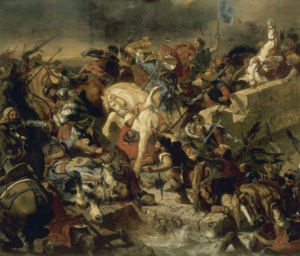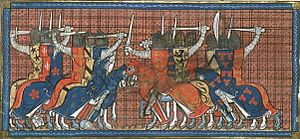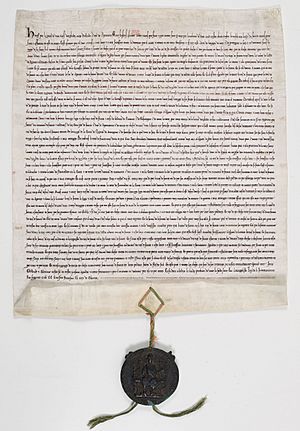Saintonge War facts for kids
Quick facts for kids Saintonge War |
|||||||
|---|---|---|---|---|---|---|---|
| Part of the Capetian–Plantagenet rivalry | |||||||
 St. Louis IX at the Battle of Taillebourg, by Eugène Delacroix |
|||||||
|
|||||||
| Belligerents | |||||||
| Commanders and leaders | |||||||
| Strength | |||||||
|
Contemporary sources: 50,000 Modern estimates: ~25,000 |
~30,000 | ||||||
| Casualties and losses | |||||||
| light | heavy | ||||||
The Saintonge War was a conflict between France and England. It happened between 1242 and 1243. The war was fought over who should control lands in France. King Louis IX of France and his brother Alphonse fought against King Henry III of England. Henry III wanted to get back lands his father had lost. Most of the fighting took place in a region called Saintonge in central-west France.
The war started because some French nobles in Poitou were unhappy. They did not want Louis's brother Alphonse to be their count. They preferred the English king's brother, Richard of Cornwall. France won important battles, like the Battle of Taillebourg. They also won the Siege of Saintes. This war was the last big fight between England and France for many years. It showed that Henry III could not get back the lands his family had lost. It also caused problems for Henry III in England.
Contents
Why the War Started: A Noble Revolt
The Saintonge War was part of a long rivalry. This rivalry was between the French and English kings. It was a bit like a warm-up to the later Hundred Years' War. The main reason for this war was a revolt by a French noble. His name was Hugh X, Lord of Lusignan.
Land Disputes and New Titles
Years before, King Philip Augustus of France had taken lands from King John of England. These lands included Poitiers. After King John died, his son Richard of Cornwall was technically the Count of Poitiers. But this was only a title. King Louis VIII of France gave the real title to his second son, Alphonse.
Alphonse could not take control of his lands until he was 18. He finally did so in 1240. In 1241, King Louis IX of France held a big meeting. He announced that Alphonse was now old enough to rule Poitou. All the local lords had to promise loyalty to Alphonse. Even the powerful Hugh X of Lusignan did so.
Unhappy Nobles and a Mother's Influence
Hugh X owned many lands in Poitou. These included his family castle in Lusignan. His family had always been quite independent. They did not like the French king gaining more power.
Hugh's wife was Isabelle of Angoulême. She was also the mother of King Henry III of England. Isabelle was very upset that her son Richard did not get the Poitou title. She pushed Hugh to resist the French king. Many other nobles in Poitou felt the same way. They formed a group against the French king.
The revolt officially began in late 1241. Hugh X of Lusignan openly refused to promise loyalty to Alphonse. Raymond VII of Toulouse also joined the rebels. He wanted to get back lands he had lost in an earlier treaty.
France's Response: King Louis Acts Fast
The French royal family reacted quickly to the revolt. In January 1242, Alphonse of Poitiers called all the Poitou nobles to a meeting. Many loyal lords came. Even some who did not like Hugh X joined.
King Louis IX decided to help his brother. He wanted to take control of the County of La Marche by force. In April, Louis gathered a large army. Some people at the time said it was about 50,000 soldiers.
Marching to War
On May 9, Louis marched his army towards Montreuil-Bonnin. This was a fortress belonging to Hugh X. Louis captured many rebel castles along the way. Then he headed towards the city of Saintes.
Meanwhile, King Henry III of England and Richard left England. They sailed to France in May. They joined the French rebel nobles. Their army may have had about 30,000 soldiers. The two kings exchanged letters, but they could not agree. Henry III still hoped to get back the lands his family had lost in France. He believed Hugh X would give him strong support.
On July 16, Louis declared war on Henry III. On July 20, the French army reached Taillebourg. A big battle was about to happen there.
Battle of Taillebourg

By mid-July, Henry's army was near Tonnay-Charente. Louis's army was just north of Taillebourg. Both armies wanted to control the bridge over the Charente River. This bridge was in the town of Taillebourg.
Henry and Hugh placed their army near the village of Saint-James. They camped on the west side of the river. Louis was staying at the fortified castle of Geoffroy de Rancon. Geoffroy was the Lord of Taillebourg.
Henry sent some soldiers to protect the bridge. This led to a small fight with French troops. This happened on July 21 or 22. Louis then launched a full attack with his entire army. The French attacks were very strong. The English king and the rebel nobles fled south to Saintes. A long fight continued north of Saintes. But the English were clearly defeated. Louis lost fewer men. However, a disease spread through his army. This forced Louis and his men to return to Paris by August.
Siege of Saintes
On July 22 or 23, the French army began to attack the city of Saintes. King Henry III realized that Hugh X did not have as much support as he had claimed. So Henry withdrew his forces to Bordeaux. Soon after, the people of Saintes gave their city to Louis.
Ending the Revolt in France
Hugh X knew he had no chance after the siege of Saintes. He surrendered to Louis on July 24. The end of the revolt was very bad for Hugh. His castles in Poitou were taken away. Alphonse of Poitiers then sold them. Hugh had to humble himself before Louis. He knelt and cried with his wife and three sons. He begged for forgiveness.
During this time, Raymond of Toulouse started his own fight against the king. He captured the cities of Narbonne and Albi in August. But Raymond had a problem. Roger IV, the Count of Foix, was Raymond's vassal. Roger stubbornly fought against Raymond. He would only obey the king. This gave Louis time to gather another army. He split it into two to retake the captured cities. By November 30, the war with Raymond ended. Raymond's fight with Roger continued until January 1243. Raymond lost again. He was forced to give up the two cities he had taken. He also promised to fight against a religious group called the Cathars. In return, the king pardoned him.
Blockade of La Rochelle
Henry III made one last effort to stop France. He wanted to prevent them from taking all his lands. So he blocked the port city of La Rochelle by sea. He hoped this would distract the French army. But the blockade did not work well. The war's outcome was already decided.
Henry looked for new allies. In January 1243, he wrote to Frederick II. Frederick was the Holy Roman Emperor. Henry had asked him for an alliance earlier. In the letter, Henry said he had lost hope of getting his French lands back. On March 12, Henry had to ask Louis for a five-year truce.
France and England Make Peace
A truce was signed in Pons on August 1. A more lasting peace treaty was made in Paris on December 4, 1259. This happened when there was a threat of another war in England.
At first, Henry did not want to give up his family's old lands in France. But Louis gave Guyenne back to Henry. Louis thought this kind act would bring a long period of peace. He really wanted to go on a religious journey called the Seventh Crusade in 1248. He needed peace to get support for it.
By signing the treaty, Louis and Henry ended a very old conflict. This conflict was between the French Capetian family and the English Plantagenet family. It was about lands that Henry II of England had inherited. These lands were later conquered by Philip Augustus of France.
With this treaty, Henry III gave up his claims to Normandy, Anjou, Touraine, Maine, and Poitou. In return, Louis IX gave him money. This money was enough to pay 500 knights for two years. He also gave Henry the income from other areas.
The treaty was first approved by Richard of Cornwall in February 1259. Then, it was approved in Westminster by Henry's representatives. By December 4, other important people also approved it. Finally, Henry came to France on December 4. He paid respect to Louis. This act officially ended their rivalry.
Afterward, the two kings became good friends. Louis even gave Henry an elephant. The Sultan of Egypt had given it to Louis. Louis also supported Henry's power in England.
Historical Background: A Long Rivalry
In English history, the 'Hundred Years' War' usually means the period from 1337 to 1453. This was a 116-year conflict. Some French historians call that period the 'Second Hundred Years' War'.
They say the 'First Hundred Years' War' was from 1159 to 1259. This earlier period began when Henry II of England married Eleanor of Aquitaine. He gained many French lands through this marriage. This made the English king more powerful than the French king. This period lasted until the Treaty of Paris (1259). After that treaty, the French king became more powerful. Many battles and conflicts happened during this time. These included the Anglo-French War (1202–1214) and the Battle of Bouvines.


